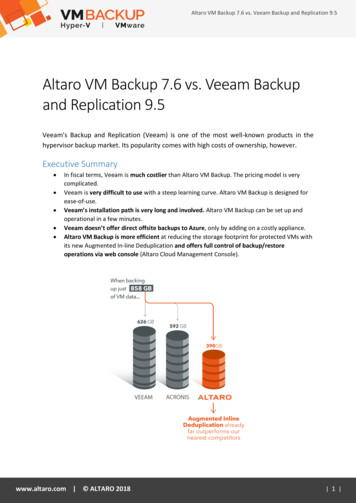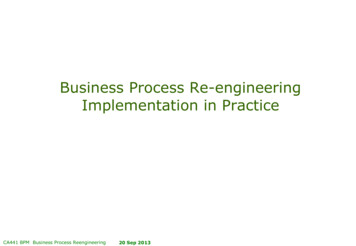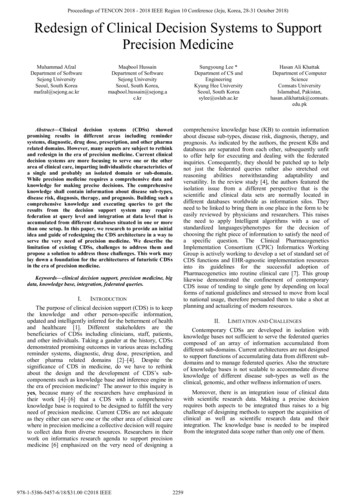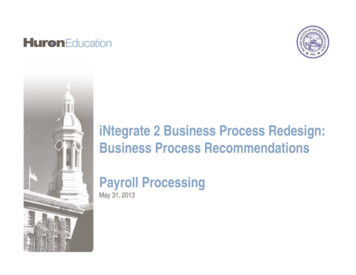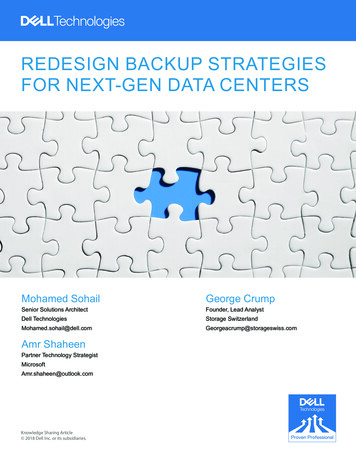
Transcription
REDESIGN BACKUP STRATEGIESFOR NEXT-GEN DATA CENTERSMohamed SohailGeorge CrumpDell TechnologiesStorage rageswiss.comSenior Solutions ArchitectAmr ShaheenPartner Technology e Sharing Article 2018 Dell Inc. or its subsidiaries.Founder, Lead Analyst
Table of ContentsThe Cyber-Attack Challenge . 4Responding to the New Threat Landscape . 5Protected Data is Now THE Target of Attacks. 5Protecting Protected Data . 7Modern Backup Strategies Need New Recovery Processes . 8Recovery Speed and Data Capture Intervals Are Still Critical. 8Introduction to Isolated Recovery . 9Modernizing Data Protection for Data Privacy & Ransomware . 9Air Gap solution design . 10Solution components. 10Compute vault . 12Management host . 12Backup application host . 12Recovery test host . 12Infrastructure services hosts . 12Low speed switch. 12High speed switch . 12Data Domain system. 12Considerations . 13A)Isolation. 13B)Backup . 14C)Recovery. 14Scenarios of implementation . 14Shared Switch . 14Dedicated Switch . 16Firewalled Vault . 17Appliance . 18Cloud Business Continuity and Disaster Recovery Strategy . 191- DR for your Cloud VMs (IaaS VM Backup) . 202-DR for your cloud-aware Applications . 213-DR for your Hybrid Environment . 234-Same Cloud DR between two regions. 245-Multi-Cloud DR . 25Summary . 26References . 27Disclaimer: The views, processes or methodologies published in this article are those of the authors. They do notnecessarily reflect Dell Technologies’ views, processes or methodologies.2019 Dell Technologies Proven Professional Knowledge Sharing2
Forgive me, for I have sinned.I have sacrificed backup consistency to get better benchmark numbers.I have failed to write tests that simulate failures properly.I have tested on too few nodes or threads to get meaningful results.I have tweaked timeout values to make the tests pass.I have failed to monitor my environment to find out where the real challenges.I know I am not alone in doing these things, but I alone can repent, and I alone can try to dobetter. I pray for the guidance please give me the strength to sin . No more.2019 Dell Technologies Proven Professional Knowledge Sharing3
The threat landscape has changed, and backup strategies need to change to keep pace. In the past, anorganization’s primary motivation for developing a backup strategy was recovery from a data center-widedisaster or to recover from data loss because of human error. While those concerns remain, the primarythreat facing the data center today is cyber-attack. The organization needs to do everything reasonableto stop a cyber-breach with perimeter defenses, but they also need to make sure they have processes tolimit the exposure of a successful breach and speed the recovery from a breach.The Cyber-Attack ChallengeA data center disaster caused by natural circumstances (flood, hurricane, power outage) is challengingbecause of the logistics required to recover. In most cases, the organization needs to recover to analternate facility, either to another one of their datacenters or in the cloud. The organization must alsomake sure that secondary locations are accessible to essential personnel to ensure that operations can beresumed seamlessly.A cyber-attack is unique because, in most cases, personnel don’t need relocation, but hardware andsoftware need a thorough inspection to make sure they are clean ofattacking code. Like a natural disaster, a cyber-attack can createmillions of dollars’ worth of damage but without causing anyphysical damage. Also, a natural disaster doesn't typically continueto attack over and over again. Once the disaster has passedorganizations can focus on recovery efforts without much concern of a repeated attack. A cyber-attack,however, can continue to threaten the organization indefinitely. NotPetya was an attack on retailcompanies that are estimated in 15 million per day was lost in forgone revenue. It spreads in secondsafter the initial infection. Interconnected businesses help automate and streamline processes, howeversuch attacks rendered useless hundreds of critical servers, desktops, and phones, impacting over 10,000employees. The production of more than 15 factories was brought to a stop. This included real-timeinventory management systems, where the downtime of these systems directly impacted the overallsupply chain, impacting final assembly of goods.The malware exploited known vulnerabilities in operating systems and found their way into third partysoftware that is consumed by the organization. The malware was inserted into a patch of this software.Rather than pay the ransom, the organization decided to focus on recovery. Paying ransom is notrecommended and would have not been effective in this case. Hackers promised a decryption key upon2019 Dell Technologies Proven Professional Knowledge Sharing4
ransom payment. Forensic analysis of the malware determined that a decryption key would not haveallowed the data to be recovered.Finally, while a natural disaster may attempt to destroy everything in its path including the data centerand everything it contains including data, it does not typically target facilities anddata that are off-site, thousands of miles away. However, some cyber-attacksspecifically try to find and eliminate backed up data first before compromising therest of the environment. These pre-strike efforts include trying to find all connected copies of data nomatter how far away they are from the data center. Even attacks that don't specifically attack protectedcopies can accidentally find their way to that data if the organization does not take the right precautions.Responding to the New Threat LandscapeThe modern data center needs to respond differently to the new cyber-attack threat. In addition to offsite data copies for protection from a data center-wide threats like a natural disaster, the organizationneeds to protect off-site data to make sure that protected copies of data are isolated and minimize pointsof access to it. IT also needs to take extra time in recovery to make sure that it is not recoveringcompromised data or malware files that can re-start the attack.Protected Data is Now THE Target of AttacksWhen malware or some other form of cyber-attack breaches an organization, the backup process issupposed to be the last line of defense, enabling the organization torecover from the attack without much, if any, data loss. The problem isthat cyber-attackers know that organizations count on the backupprocess and as a result, backup data is also a target of these attacks. Badactors can compromise the backup process by either removing orcorrupting backup data stores and configuration files, or by inserting nefarious code into the backup store.Cyber-attacks can directly attack backup data by either encrypting the backup data store or completelyremoving it. If part of the backup policy is to replicate the backup store to an offsite location, the cyberattack can follow the path to the replication site and also remove the DR copy of the backup data store.The success rate of the attack is dependent on what level of access the attacker gains, but all online copiesof backup data are specifically susceptible. The attacker may also gain access to the backup software’sconfiguration files and metadata history files.2019 Dell Technologies Proven Professional Knowledge Sharing5
Once the attacker corrupts the backup data or backup configuration files, they can start attackingproduction data, knowing that the organization can't recover, and can hold the organization hostage.Once the organization identifies the attack on production storage, it turns to its backup data to recover,only to find that the attacker has compromised it as well. The only option is for the organization to dealwith the public embarrassment of admitting to the attack. It may also need to pay the attacker to releasetheir data.A subtler attack, yet one that is simpler to accomplish is to insert nefarious codeinto the backup data store by placing attack trigger files on production storage butnot triggering them until they have been backed up. Most backup solutions haveno insight into what data they are backing up. They are just doing as ordered andbacking up a specific file system, volume or mount point. If the attacker can inserttheir code into those file systems or mount points, then the backup system backs it up.The bad actor only needs to be patient and not trigger the attack right away. Instead, they wait for theirfiles to be backed up several times before executing. After the attack occurs, and IT eventually discoversit, IT then resorts to its normal process of recovery from the backup. One can assume that IT first removesthe trigger files from primary storage, which then makes them believe they have stopped the attack. Theproblem is the restore process also restores the original trigger files along with all the other files. Oncerestored the trigger files activate again, compromising systems and data. The organization finds itselftrapped in an attack loop.2019 Dell Technologies Proven Professional Knowledge Sharing6
Protecting Protected DataProtected data is the data that the backup process creates and updates as part of the backup process. Therise in cyber-attack related disasters means that organizations need to look at new methods to make theprotected data resilient to attack and it needs to change its recovery methods. Organizations need tomake sure some of the protected copies of data have a gap in time from protected data. Moreimportantly, some copies of the protected data need to be more difficult to access from the network. Thisdata is typically considered off-line creating an air gap.The problem with creating these gaps is data protection software continues to improve, and more of theprotected data is online than in the past when tape was the only backupmedium. Modern solutions can make copies of data more frequently thanever, which while improving recovery point objectives also exposes protectedcopies of data to corruption from cyber-attack. Software vendors need todeliver solutions that can quickly secure protected copies of data. IT professionals should also take stepsto make sure that protected data is secure.The most vulnerable data is data that is accessible via Windows SMB shares or on Windows volumes. Abackup solution that is either Linux-based, or Windows-based but supports writing to an NFS or ObjectStorage mount point eliminates about 80% of the concern. Linux-based backup servers should similarlywrite data to an SMB mount or to a Cloud Storage location. To date, there is no known case of a crossplatform attack. Most cyber-attacks are written for a single platform and don’t move across operatingsystems or mount types.2019 Dell Technologies Proven Professional Knowledge Sharing7
The next step is to create a gap in connectivity or an air-gap so that the cyber-attack can’t follow the pathto the protected data. Tape vendors claim superiority here since tape librariesaren’t typically accessible by operating system mount points. Cloud vendors,however, can offer similar air-gapped protection by copying data via native cloudprotocols and saving replicated backup copies to a write-once, read many(WORM) file system at a cloud provider. Object or Cloud Storage support provides the protocol switchdescribed above and a WORM file system makes changes to the underlying protected data impossible.The organization can also go a step further and make sure the cloud account only provides minimal accesscredentials.The advantage of a cloud copy is random access and no waiting for tape mounts. Data can also be quicklyscanned for verification, a critical capability when dealing with attack loops.Modern Backup Strategies Need New Recovery ProcessesThe default recovery protocol is to recover data as quickly as possible with minimal data loss, and there isincreasing pressure on IT to meet these demands with greater regularity. Vendors continue to improvetheir ability to recover data rapidly and to reduce data loss. Malware and other cyber-threats, however,means that data centers can’t focus only on rapid recovery; they must also have the option to perform anisolated recovery so that data is analyzed before being moved into production.Recovery Speed and Data Capture Intervals Are Still CriticalWhile cyber-attack is a constant threat, it is unlikely that organizations are in the midst of an attack all thetime. The majority of recoveries are a result of accidental user deletion or application corruption of datamoreso than the need to eliminate the damages caused by a malware attack, which means recovery speedand lack of data loss are the priorities the vast majority of the time.Organizations can’t afford to solely focus on recovery from malware or ransomware because the bestpractices of recovery require the organization to perform a staged recovery which adds time and losesdata fidelity. IT needs to continue to invest in software and hardware solutions that improve the ability torecover rapidly and to capture backup copies more frequently.2019 Dell Technologies Proven Professional Knowledge Sharing8
Introduction to Isolated RecoveryWhen an organization needs to recover from a malware or cyber-attack, in most cases it knows that it isinvolved in that situation due to the scope of the restore request. In these situations, organizations needto perform a staged recovery. A staged recovery means restoring to anisolated section, sometimes called a Sandbox, of the data center or anisolated section of the cloud so that the backup data is verified beforemoving it to production storage. Once IT restores the data to the isolatedarea, it can use standard malware scanning solutions to verify that silenttrigger files don’t exist and that data within the restore set is free from corruption. If IT finds a malwaretrigger file or corrupted data, they need to move to the next previous backup set or try to manually extractmalware and corrupted data from the currently restored set.If the data set from a backup is found malware- and corruption-free, IT can execute the same recoveryprocess to production stores. The process is of necessity a double restore, and IT needs to factor in thetime involved in its recovery expectations.If IT decides to use a recovered set with malware or corrupted data removed instead of utilizing a previousbackup generation, backup administrators need to take great care when copying this data to productionstorage. A straight copy of data from the staged recovery area to production storage may not transfer allthe file attributes correctly. The process is similar to migrating data from one storage system to another,and the organization may want to use a replication utility to perform the transfer.Modernizing Data Protection for Data Privacy & RansomwareTo tackle such challenges, we propose two ways that are considered successful and can be easilycombined to achieve the best-of-breed solutions for customers who have mission-critical applications,including those who can’t be completely on cloud – i.e. Banking sector.The rest of this paper details the above concepts, but it is critical that the organization place a high priorityon backup modernization. There is a temptation, especially with backup, to take an “if it ain’t broke, don’tfix it” attitude. This attitude is dangerous. The threat landscape is changing, and organizations need toprepare now by constantly challenging their backup and recovery methodologies to make sure they areready for the next potential threat.2019 Dell Technologies Proven Professional Knowledge Sharing9
Air Gap solution designSolution componentsAny device on the Internet with an open inbound port will be attacked. It’s a matter of when, not if. Thisis the philosop
2019 Dell Technologies Proven Professional Knowledge Sharing 6 Once the attacker corrupts the backup data or backup configuration files, they can start attacking production data, knowing that the organization can't recover, and can hold the organization hostage.


